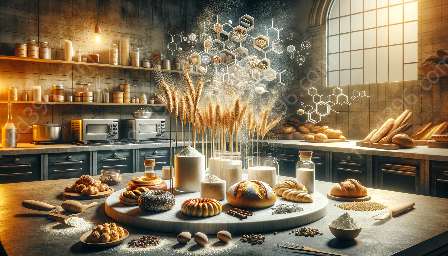As an essential component of many baked goods, dairy products such as milk, cream, yogurt, and buttermilk play crucial roles in the flavor, texture, and overall success of a recipe. Understanding their compatibility with flour and other baking ingredients, as well as the science and technology behind their use, is key to achieving outstanding results in baking.
The Role of Dairy Products in Baking
Dairy products bring richness, moisture, and tenderness to various baked goods. They also contribute to the flavor, aroma, and color of the final products. Let's explore the specific roles of different dairy products in baking:
- Milk: Often used as a liquid component in batters, doughs, and glazes, milk provides moisture and helps create a tender crumb in cakes, muffins, and breads. It also contributes to the browning and flavor development of baked goods.
- Cream: With its higher fat content, cream adds richness, smoothness, and a luxurious mouthfeel to desserts such as custards, ice creams, and ganaches. It can also be whipped to produce luscious toppings for pies and cakes.
- Yogurt: Besides offering moisture and tangy flavor, yogurt brings acidity and tenderizing properties to baked goods. It also enhances the texture and structure of items like quick breads, muffins, and scones.
- Buttermilk: Its acidic nature contributes to leavening and tenderness in baked goods. Buttermilk also adds a subtle tanginess and moistness to pancakes, waffles, and biscuits.
Compatibility with Flour and Other Baking Ingredients
Understanding how dairy products interact with flour and other baking ingredients is crucial for achieving the desired outcomes in baking. Here's how they complement each other:
Dairy Products and Flour:
Milk and cream hydrate the flour to form a dough or batter, while also influencing its consistency and structure. The proteins and fats in dairy products interact with the gluten in flour, affecting the texture and elasticity of the final baked goods.
Dairy Products and Leavening Agents:
The acidity in yogurt and buttermilk reacts with leavening agents such as baking soda and baking powder, resulting in the production of carbon dioxide gas. This gas helps the batter or dough rise, leading to a lighter and more airy texture in the finished products.
Dairy Products and Sweeteners:
The sweetness of dairy products like cream and condensed milk complements the overall sweetness in baked goods, allowing for balanced flavor profiles. In addition, these products contribute to the tenderizing effect and browning reactions in conjunction with sugars.
Baking Science & Technology
Behind the art of baking lies a fascinating world of science and technology. When it comes to dairy products, the following scientific principles come into play:
Dairy Protein Denaturation:
During the baking process, the proteins in dairy products undergo denaturation, altering their structure and contributing to the texture, stability, and browning of the baked goods. Understanding the denaturation process helps bakers manipulate the final properties of their products.
Emulsification and Aeration:
Cream and milk can act as emulsifiers and aeration agents in batters and doughs, leading to smoother textures and better volume in cakes, mousses, and other aerated desserts. The science behind these processes involves the formation and stabilization of air bubbles within the mixture.
Acid-Base Reactions:
The acidic nature of yogurt and buttermilk interacts with alkaline leavening agents to produce carbon dioxide gas, which is crucial for the leavening and rise of various baked goods. Understanding these chemical reactions is essential for achieving the desired textures in baked items.
Heat Transfer and Maillard Reaction:
When dairy products are subjected to heat during baking, they participate in the Maillard reaction, leading to the development of desirable flavors, colors, and aromas in the finished products. Controlling heat transfer and understanding the Maillard reaction is fundamental for achieving optimal results.
Conclusion
The use of dairy products in baking is not only about adding flavor and moisture; it involves a deep understanding of their interactions with flour, leavening agents, sweeteners, and the scientific principles that govern the baking process. By delving into the roles of dairy products, their compatibility with other baking ingredients, and the underlying science and technology, bakers can elevate their skills and create exceptional baked goods that delight the senses.

